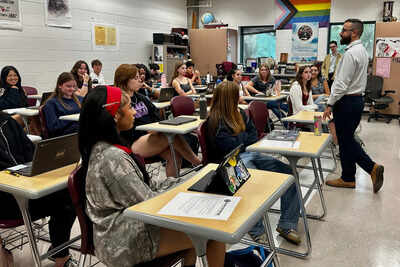ARTICLE AD BOX

For years, the phrase “teacher shortage” has dominated conversations about US schools. Headlines warned of classrooms without instructors, districts sounded alarms about recruitment, and policymakers scrambled to respond.
But new data suggests the shortage story may be more illusion than reality, and that the real crisis runs deeper, hiding in plain sight.According to K-12 Dive, the end of federal pandemic aid and falling student enrollment are forcing school leaders to make tough staffing decisions. Districts spent billions of dollars from the Elementary and Secondary School Emergency Relief (ESSER) fund to hire more teachers, even as student numbers declined.Now, as those pandemic-era dollars run out, schools are not just tightening budgets. They’re considering consolidations, closures, and layoffs. “Because some districts chose to hire despite declining enrollment, they are laying off staff or implementing hiring freezes,” said Marguerite Roza, director of Georgetown University’s Edunomics Lab, in an interview with K-12 Dive.
The ‘shortage’ that isn’t
On paper, the US has never had more teachers per student. Thomas Dee, professor at Stanford University, found that in 2022, the student-teacher ratio dropped to its lowest point in modern history: From 16.4 students per teacher in 2010 to 15.4 in 2022. A K-12 Dive analysis further confirmed that 43 states plus D.C. now have fewer students per teacher than before COVID-19.
“There are many more teachers per students than ever before in US history,” Dee told K-12 Dive.The phrase “teacher shortage,” he argues, oversimplifies a much more complex problem. Schools aren’t short of teachers overall, they’re short of them in the places and subjects that matter most.
Where the gaps really are
Rural districts. High-poverty schools. STEM and special education roles. Those are the places still struggling to find staff.
“It doesn’t mean that every spot has been filled,” Roza cautioned. Recruiting math teachers or special educators remains stubbornly difficult, regardless of how many more English or elementary teachers a district may have.Take Arizona’s Deer Valley Unified School District. As enrollment shrank by 1.5% between 2021 and 2023, Superintendent Curtis Finch had to cut about 50 positions. Yet, even as staff were let go, the district still couldn’t fill science and special education jobs.
“We’re at the tip of the educational experiment,” Finch said of Arizona’s sweeping school choice program, which has siphoned students, and funding, from public schools since 2022.
What schools are trying
Deer Valley USD has leaned on a grow-your-own teacher prep program, training local graduates to become certified teachers. Of the 160 participants so far, 95% have stayed to teach in the district. It’s a bright spot, but not a silver bullet.Education finance experts say districts will need to get sharper about returns on investment. That could mean paying effective teachers more, weeding out uncertified ones, or streamlining certification rules across state lines.
The real crisis
If the teacher shortage isn’t really about numbers, what is it about? According to Dee, it’s about equity. The students most in need — in underserved, rural, or high-poverty communities — are the ones least likely to have access to quality teachers.“The issue is hard-to-staff schools and hard-to-staff subjects,” Dee told K-12 Dive. The real question, then, isn’t whether America has enough teachers. It’s whether the system can deliver the right teachers to the right classrooms.And that reframes the crisis entirely.TOI Education is on WhatsApp now. Follow us here.



.png)
.png)
.png)
















 22 hours ago
3
22 hours ago
3








 English (US) ·
English (US) ·